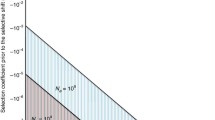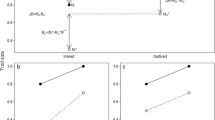Abstract
Dobzhansky studied mechanisms of balancing selection using systems of inversions in Drosophila and he soon found that changes in inversion frequencies along generations in experimental populations conformed to the expectation for a simple model of heterosis. However, other more complex modes of selection, like rare male advantage, were later found to affect the maintenance of inversion polymorphisms. Here we show that a more realistic (and complex) model than heterosis—integrating all known fitness component estimates obtained in independent experiments for the ST/CH system of inversions in Drosophila pseudoobscura—not only conforms to but actually also predicts the inversion frequencies. This concludes this line of work and points to other selection mechanisms than heterosis that were also considered by Dobzhansky—frequency- and sex-dependent selection—as potential mechanisms of balancing selection responsible for the maintenance of the inversion polymorphisms in Drosophila.

Similar content being viewed by others
References
Álvarez-Castro, J. M., & Alvarez, G. (2005). Models of general frequency-dependent selection and mating-interaction effects and the analysis of selection patterns in Drosophila inversion polymorphisms. Genetics, 170(3), 1167–1179. doi:10.1534/genetics.104.037754.
Anderson, W. W., Arnold, J., Sammons, S. A., & Yardley, D. G. (1986). Frequency-dependent viabilities of Drosophila pseudoobscura karyotypes. Heredity, 56, 7–17. doi:10.1038/hdy.1986.2.
Anderson, W. W., & Brown, C. J. (1984). A test for rare male mating advantage with Drosophila pseudoobscura karyotypes. Genetics, 107(4), 577–589.
Anderson, W. W., & Watanabe, T. K. (1997). A demographic approach to selection. Proceedings of the National Academy of Sciences of the USA, 94(15), 7742–7747. doi:10.1073/pnas.94.15.7742.
Barahona, A., & Ayala, F. J. (2005). Theodosius Dobzhansky’s role in the emergence and institutionalization of genetics in Mexico. Genetics, 170(3), 981–987.
Bürger, R. (2000). The mathematical theory of selection, recombination and mutation. Chichester: Wiley.
Charlesworth, B. (1996). The good fairy godmother of evolutionary genetics. Current Biology, 6(3), 220. doi:10.1016/S0960-9822(02)00457-8.
Charlesworth, B., & Charlesworth, D. (1975). An experiment on recombination load in Drosophila melanogaster. Genetical Research Camb., 25, 267–274.
Coyne, J. A., & Orr, H. A. (2004). Speciation. Sunderland: Sinauer.
Dobzhansky, T. (1937). Genetics and the origin of species. New York: Columbia University Press.
Dobzhansky, T. (1943). Genetics of natural populations IX. Temporal changes in the composition of populations of Drosophila pseudoobscura. Genetics, 28(2), 162–186.
Dobzhansky, T. (1947). Genetics of natural populations XIV. A response of certain gene arrangements in the third chromosome of Drosophila pseudoobscura to natural selection. Genetics, 28, 288–302.
Dobzhansky, T. (1948). Genetics of natural populations XVI. Altitudinal and seasonal changes produced by natural selection in certain populations of Drosophila pseudoobscura. Genetics, (35), 158–176.
Dobzhansky, T. (1950). Genetics of natural populations. XIX. Origin of heterosis through natural selection in populations of Drosophila pseudoobscura. Genetics, 35(3), 288–302.
Dobzhansky, T. (1970). Genetics of the evolutionary process. New York: Columbia University Press.
Dobzhansky, T. (1981). Dobzhansky’s genetics of natural populations I–XLIII. In R. C. Lewontin, J. A. Moore, W. B. Provine, & B. Wallace (Ed.). New York: Columbia University Press.
Dobzhansky, T., Anderson, W. W., & Pavlovsky, O. (1966). Genetics of natural populations XXVIII. Continuity and change in populations of Drosophila pseudoobscura in wastern United States. Evolution; International Journal of Organic Evolution, 20, 418–427. doi:10.2307/2406640.
Dobzhansky, T., & Pavlovsky, O. (1953). Indeterminate outcome of certain experiments of Drosophila populations. Evolution; International Journal of Organic Evolution, 7, 198–210. doi:10.2307/2405731.
Dobzhansky, T., & Pavlovsky, O. (1957). An experimental study of interaction between genetic drift and natural selection. Evolution; International Journal of Organic Evolution, 11, 311–319. doi:10.2307/2405795.
Drugger, M. (1966). Stability of chromosomal polymorphism in populations of Drosophila pseudoobscura. Heredity, 21, 317–321. doi:10.1038/hdy.1966.27.
Drugger, M., & Nickerson, R. P. (1972). Maintenance of chromosomal polymorphism in a population of Drosophila pseudoobscura: Viability under crowded and uncrowded conditions. Evolution; International Journal of Organic Evolution, 26, 322–325. doi:10.2307/2407007.
Ehrman, L., Spassky, B., Pavlovsky, O., & Dobzhansky, T. (1965). Sexual selection, geotaxis, and chromosomal polymorphism in experimental populations of Drosophila subobscura. Evolution; International Journal of Organic Evolution, 19, 337–346. doi:10.2307/2406443.
Gavrilets, S. (2004). Fitness landscapes and the origin of species. New Jersey: Princeton University Press.
Hedrick, M. W., & Murray, E. (1983). Selection and measures of fitness. In M. Ashburner, H. Carson & J. N. Thompson Jr. (Eds.), The genetics and biology of Drosophila (pp. 61–104). London: Academic Press.
Hoffmann, A. A., Sgro, C. M., & Weeks, A. R. (2004). Chromosomal inversion polymorphisms and adaptation. Trends in Ecology & Evolution, 19(9), 482–488. doi:10.1016/j.tree.2004.06.013.
Krimbas, C. B., & Powell, J. R. (Eds.) (1992). Drosophila inversion polymorphism. Boca Raton, FL: CRC Press.
Mayr, E. (1942). Systematics and the origin of species. New York: Columbia University Press.
Moos, J. R. (1955). Comparative phisiology of some chromosomal types in Drosophila pseudoobscura. Evolution; International Journal of Organic Evolution, 9, 141–151. doi:10.2307/2405585.
Petit, C., & Ehrman, L. (1969). Sexual selection in Drosophila. Evolutionary Biology, 3, 177–223.
Powell, J. R. (1987). In the air—Theodosius Dobzhansky’s genetics and the origin of species. Genetics, 117(3), 363–366.
Powell, J. R. (1997). Progress and prospects in evolutionary biology. The Drosophila model. Oxford: Oxford University Press.
Prout, T. (1965). The estimation of fitness from genotypic frequencies. Evolution; International Journal of Organic Evolution, 19, 546–551. doi:10.2307/2406251.
Prout, T. (1969). The estimation of fitness from population data. Genetics, 63(4), 949–967.
Prout, T. (1971a). The relation between fitness components and population prediction in Drosophila. I: The estimation of fitness components. Genetics, 68(1), 127–149.
Prout, T. (1971b). The relation between fitness components and population prediction in Drosophila. II: Population prediction. Genetics, 68(1), 151–167.
Sarkar, S. (2004). Fron the reaktionsnorm to the evolution of adaptive plasticity: A historical sketch, 1909–1999. In T. J. DeWitt & S. M. Scheiner (Eds.), Phenotypic plasticity. New York: Oxford University Press.
Sperlich, D., & Pfriem, P. (1986). Chromosomal polymorphism in natural and experimental populations. In M. Ashburner, H. L. Carson & J. N. Thompson Jr. (Eds.), The genetics and biology of Drosophila (pp. 257–309). London: Academy Press.
Simpson, G. G. (1944). Tempo and mode in evolution. New York: Columbia University Press.
Stebbins, G. L. (1950). Variation and evolution in plants. New York: Columbia University Press.
Wasserman, M., & Koepfer, H. R. (1975). Fitness of karyotypes in Drosophila pseudoobscura. Genetics, 79(1), 113–126.
Wright, S., & Dobzhansky, T. (1946). Genetics of natural populations. XII. Experimental reproduction of some of the changes caused by natural selection in certain populations of Drosophila pseudoobscura. Genetics, 31(2), 125–156.
Author information
Authors and Affiliations
Corresponding author
Appendix
Appendix
The model of selection we used to obtain our fitness-component-based predicted trajectories has been developed by Álvarez-Castro and Alvarez (2005). Its recurrence equations can be expressed as follows. The adult-to-zygote step can be modeled as
where X, Y and Z, are the frequencies of the three genotypes, ST/ST, ST/CH and CH/CH, the subindex zy means zygote (adult frequencies otherwise), the prime means “at the following generation”, f i (X,Z) and m i (X,Z), i = 1,2,3, are the female and male multiplicative frequency-dependent fertilities, and
such that the frequencies \( X^{\prime}_{{zy}} \), \( Y^{\prime}_{{zy}} \) and \( Z^{\prime}_{{zy}} \) add to unity. The adult-to-adult recurrence equations can now be expressed as
where v i (X zy , Z zy ), i = 1,2,3, are the frequency-dependent viabilities, the zygote frequencies \( X^{\prime}_{{zy}} \) and \( Z^{\prime}_{{zy}} \) are given by (1), and \( \bar w \) is such that X′ + Y′ + Z′ = 1.
The implementation of these equations with overlapping generations consists in recomputing the vector of frequencies at the adult stage, (X, Y, Z), each generation as
where the asterisk stands for “at the previous generation” and Ov is the degree of overlapping—expressed as the frequency of individuals from the previous generation that remain in the current one, between zero and one. We considered degrees of overlapping between 0 and 0.25.
Random fluctuations of frequencies could make the populations to on average faster approach the orbit of the stable equilibrium of the genetic system. Thus, we have implemented drift in the model using a binomial distribution (Bürger 2000). In particular, we have further recomputed the vector of frequencies by adding to each frequency a random number drawn from a binomial distribution with index 2N and the frequency divided by 2N as parameter, where N is the number of individuals per generation. The frequencies were normalized back after adding the random numbers. For the population sizes we dealt with—N = 1500 (Dobzhansky and Pavlovsky 1953)—drift had no noticeable effect.
For the time scope of the experiment we reproduce in this article—15 generations (Dobzhansky and Pavlovsky 1953)—it is not necessary to consider long-term phenomena like mutation. We conducted simulations in Mathematica with expressions (1–3), implemented with the fitness components from the literature (Moos 1955; Anderson and Brown 1984; Anderson et al. 1986) in the very same way as described by Álvarez-Castro and Alvarez (2005).
Rights and permissions
About this article
Cite this article
Álvarez-Castro, J.M., Carlborg, Ö. The Yank of Dobzhansky’s Bequest. Evol Biol 35, 176–181 (2008). https://doi.org/10.1007/s11692-008-9028-5
Received:
Accepted:
Published:
Issue Date:
DOI: https://doi.org/10.1007/s11692-008-9028-5




